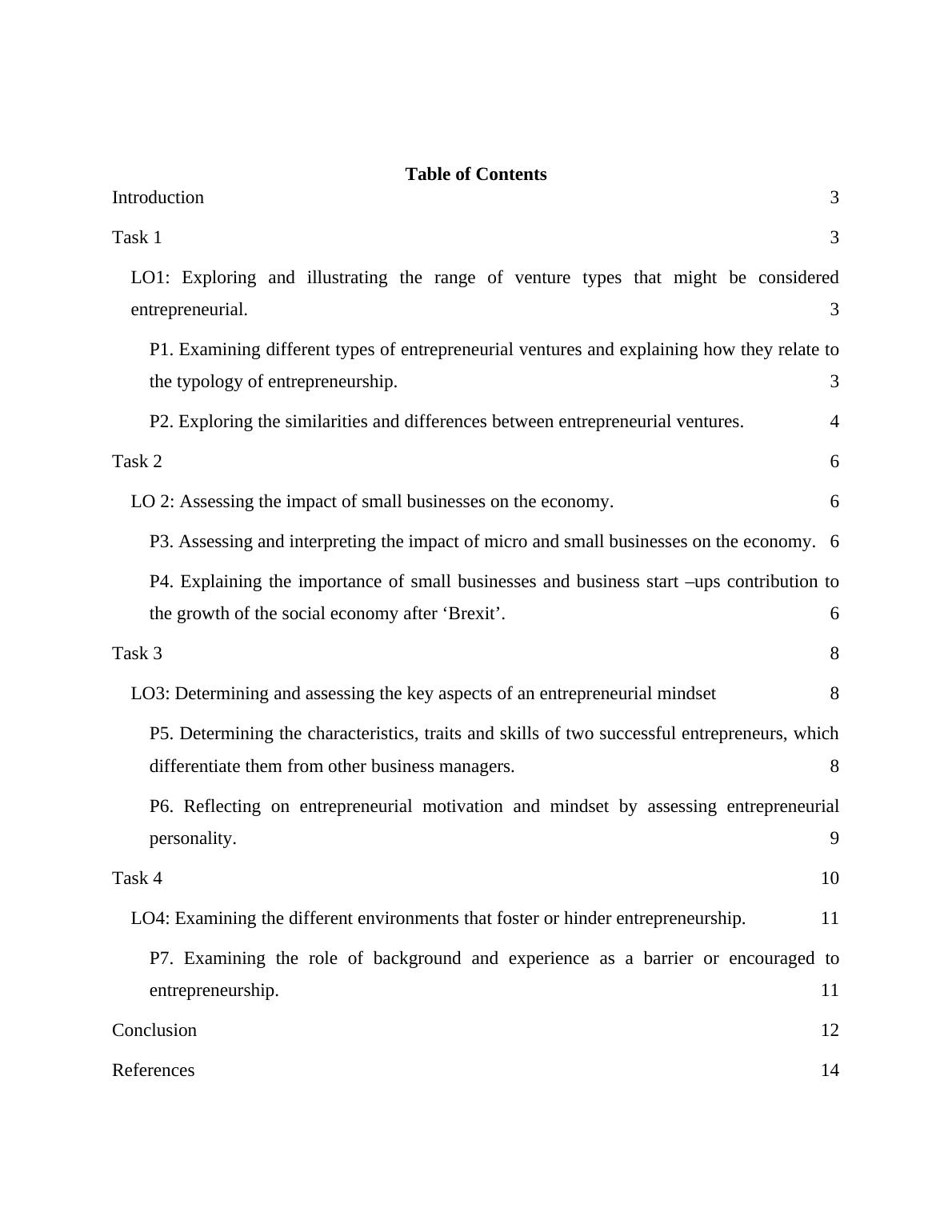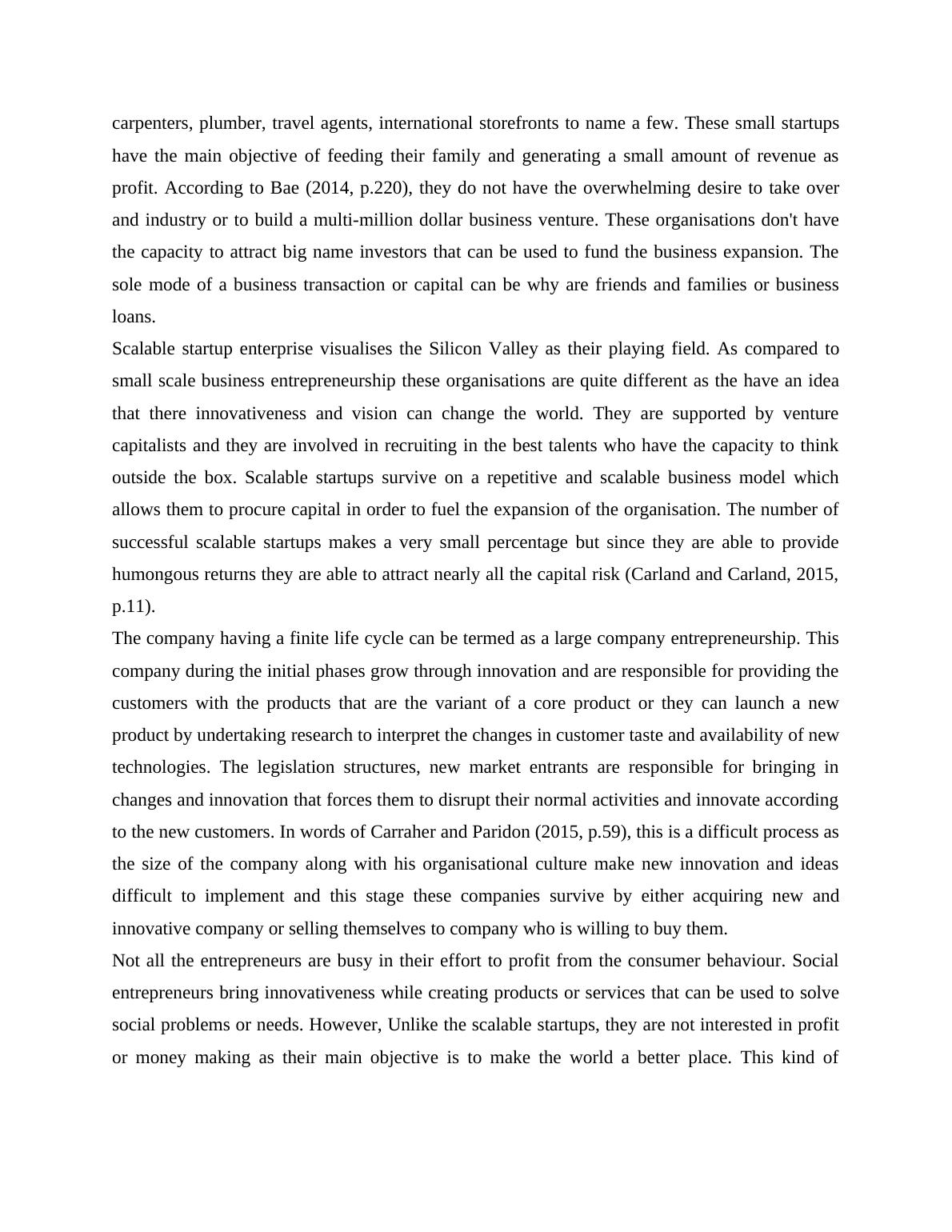Top338 - UNIT 9 EntrepreneursHIP Introduction
Added on 2020-02-03
16 Pages5292 Words194 Views
TOP338 - UNIT 9 ENTREPRENEURSHIP

Table of Contents
Introduction 3
Task 1 3
LO1: Exploring and illustrating the range of venture types that might be considered
entrepreneurial. 3
P1. Examining different types of entrepreneurial ventures and explaining how they relate to
the typology of entrepreneurship. 3
P2. Exploring the similarities and differences between entrepreneurial ventures. 4
Task 2 6
LO 2: Assessing the impact of small businesses on the economy. 6
P3. Assessing and interpreting the impact of micro and small businesses on the economy. 6
P4. Explaining the importance of small businesses and business start –ups contribution to
the growth of the social economy after ‘Brexit’. 6
Task 3 8
LO3: Determining and assessing the key aspects of an entrepreneurial mindset 8
P5. Determining the characteristics, traits and skills of two successful entrepreneurs, which
differentiate them from other business managers. 8
P6. Reflecting on entrepreneurial motivation and mindset by assessing entrepreneurial
personality. 9
Task 4 10
LO4: Examining the different environments that foster or hinder entrepreneurship. 11
P7. Examining the role of background and experience as a barrier or encouraged to
entrepreneurship. 11
Conclusion 12
References 14
Introduction 3
Task 1 3
LO1: Exploring and illustrating the range of venture types that might be considered
entrepreneurial. 3
P1. Examining different types of entrepreneurial ventures and explaining how they relate to
the typology of entrepreneurship. 3
P2. Exploring the similarities and differences between entrepreneurial ventures. 4
Task 2 6
LO 2: Assessing the impact of small businesses on the economy. 6
P3. Assessing and interpreting the impact of micro and small businesses on the economy. 6
P4. Explaining the importance of small businesses and business start –ups contribution to
the growth of the social economy after ‘Brexit’. 6
Task 3 8
LO3: Determining and assessing the key aspects of an entrepreneurial mindset 8
P5. Determining the characteristics, traits and skills of two successful entrepreneurs, which
differentiate them from other business managers. 8
P6. Reflecting on entrepreneurial motivation and mindset by assessing entrepreneurial
personality. 9
Task 4 10
LO4: Examining the different environments that foster or hinder entrepreneurship. 11
P7. Examining the role of background and experience as a barrier or encouraged to
entrepreneurship. 11
Conclusion 12
References 14

Introduction
In today's world, everyone wants to prove their merits and the current market conditions existing
in the present have enabled such individuals to take up the charge to do something innovative
and new. Entrepreneurship is a branch of business studies where an individual showing the
capacity to develop and willingness to organise as well as manage business Ventures while
taking into account the risks so as to make a profit are termed as entrepreneurs. Their business
ventures in combination with the physical and natural resources such as land, labour and capital
in order to generate revenue. The ability to take a risk in order to bring about some changes and
Revolutionary ideas into the market is the characteristic spirit of an entrepreneur. The ever
competitive global market allows them to realise their full potential. Entrepreneurship is just like
Grand link as there is no guarantee that an idea can sustain a grow in a market.
Task 1
LO1: Exploring and illustrating the range of venture types that might be considered
entrepreneurial.
P1. Examining different types of entrepreneurial ventures and explaining how they relate
to the typology of entrepreneurship.
Everyone wants to be an entrepreneur and yet they do not understand the various differences that
are present in entrepreneurship. In simple words, all kind of entrepreneurship are not same and
hence it is necessary to identify the various types of entrepreneurship that exist in the Global
market. An entrepreneurial venture is one where the inception of a business organisation
develops from limited resources and no extravagant planning. The four main type of
entrepreneurship that exists is small business entrepreneurship, scalable startup entrepreneurship,
large company entrepreneurship and Social entrepreneurship (Sheperd, 2015, p.490). All
business ideas and existing organisations present in the market are due to a moment of ingenuity
and innovativeness and hence the type of the entrepreneurship dictates the future of the
organisation.
With the Boom in personal finance and stabilising economy, there has been an overwhelming
amount of entrepreneurs and startups that have been observed all over the globe. These business
ventures are small but collectively they are the largest employers and industry present in the
current world. Small businesses can be mainly generalised as hardware stores, Consultants,
In today's world, everyone wants to prove their merits and the current market conditions existing
in the present have enabled such individuals to take up the charge to do something innovative
and new. Entrepreneurship is a branch of business studies where an individual showing the
capacity to develop and willingness to organise as well as manage business Ventures while
taking into account the risks so as to make a profit are termed as entrepreneurs. Their business
ventures in combination with the physical and natural resources such as land, labour and capital
in order to generate revenue. The ability to take a risk in order to bring about some changes and
Revolutionary ideas into the market is the characteristic spirit of an entrepreneur. The ever
competitive global market allows them to realise their full potential. Entrepreneurship is just like
Grand link as there is no guarantee that an idea can sustain a grow in a market.
Task 1
LO1: Exploring and illustrating the range of venture types that might be considered
entrepreneurial.
P1. Examining different types of entrepreneurial ventures and explaining how they relate
to the typology of entrepreneurship.
Everyone wants to be an entrepreneur and yet they do not understand the various differences that
are present in entrepreneurship. In simple words, all kind of entrepreneurship are not same and
hence it is necessary to identify the various types of entrepreneurship that exist in the Global
market. An entrepreneurial venture is one where the inception of a business organisation
develops from limited resources and no extravagant planning. The four main type of
entrepreneurship that exists is small business entrepreneurship, scalable startup entrepreneurship,
large company entrepreneurship and Social entrepreneurship (Sheperd, 2015, p.490). All
business ideas and existing organisations present in the market are due to a moment of ingenuity
and innovativeness and hence the type of the entrepreneurship dictates the future of the
organisation.
With the Boom in personal finance and stabilising economy, there has been an overwhelming
amount of entrepreneurs and startups that have been observed all over the globe. These business
ventures are small but collectively they are the largest employers and industry present in the
current world. Small businesses can be mainly generalised as hardware stores, Consultants,

carpenters, plumber, travel agents, international storefronts to name a few. These small startups
have the main objective of feeding their family and generating a small amount of revenue as
profit. According to Bae (2014, p.220), they do not have the overwhelming desire to take over
and industry or to build a multi-million dollar business venture. These organisations don't have
the capacity to attract big name investors that can be used to fund the business expansion. The
sole mode of a business transaction or capital can be why are friends and families or business
loans.
Scalable startup enterprise visualises the Silicon Valley as their playing field. As compared to
small scale business entrepreneurship these organisations are quite different as the have an idea
that there innovativeness and vision can change the world. They are supported by venture
capitalists and they are involved in recruiting in the best talents who have the capacity to think
outside the box. Scalable startups survive on a repetitive and scalable business model which
allows them to procure capital in order to fuel the expansion of the organisation. The number of
successful scalable startups makes a very small percentage but since they are able to provide
humongous returns they are able to attract nearly all the capital risk (Carland and Carland, 2015,
p.11).
The company having a finite life cycle can be termed as a large company entrepreneurship. This
company during the initial phases grow through innovation and are responsible for providing the
customers with the products that are the variant of a core product or they can launch a new
product by undertaking research to interpret the changes in customer taste and availability of new
technologies. The legislation structures, new market entrants are responsible for bringing in
changes and innovation that forces them to disrupt their normal activities and innovate according
to the new customers. In words of Carraher and Paridon (2015, p.59), this is a difficult process as
the size of the company along with his organisational culture make new innovation and ideas
difficult to implement and this stage these companies survive by either acquiring new and
innovative company or selling themselves to company who is willing to buy them.
Not all the entrepreneurs are busy in their effort to profit from the consumer behaviour. Social
entrepreneurs bring innovativeness while creating products or services that can be used to solve
social problems or needs. However, Unlike the scalable startups, they are not interested in profit
or money making as their main objective is to make the world a better place. This kind of
have the main objective of feeding their family and generating a small amount of revenue as
profit. According to Bae (2014, p.220), they do not have the overwhelming desire to take over
and industry or to build a multi-million dollar business venture. These organisations don't have
the capacity to attract big name investors that can be used to fund the business expansion. The
sole mode of a business transaction or capital can be why are friends and families or business
loans.
Scalable startup enterprise visualises the Silicon Valley as their playing field. As compared to
small scale business entrepreneurship these organisations are quite different as the have an idea
that there innovativeness and vision can change the world. They are supported by venture
capitalists and they are involved in recruiting in the best talents who have the capacity to think
outside the box. Scalable startups survive on a repetitive and scalable business model which
allows them to procure capital in order to fuel the expansion of the organisation. The number of
successful scalable startups makes a very small percentage but since they are able to provide
humongous returns they are able to attract nearly all the capital risk (Carland and Carland, 2015,
p.11).
The company having a finite life cycle can be termed as a large company entrepreneurship. This
company during the initial phases grow through innovation and are responsible for providing the
customers with the products that are the variant of a core product or they can launch a new
product by undertaking research to interpret the changes in customer taste and availability of new
technologies. The legislation structures, new market entrants are responsible for bringing in
changes and innovation that forces them to disrupt their normal activities and innovate according
to the new customers. In words of Carraher and Paridon (2015, p.59), this is a difficult process as
the size of the company along with his organisational culture make new innovation and ideas
difficult to implement and this stage these companies survive by either acquiring new and
innovative company or selling themselves to company who is willing to buy them.
Not all the entrepreneurs are busy in their effort to profit from the consumer behaviour. Social
entrepreneurs bring innovativeness while creating products or services that can be used to solve
social problems or needs. However, Unlike the scalable startups, they are not interested in profit
or money making as their main objective is to make the world a better place. This kind of

End of preview
Want to access all the pages? Upload your documents or become a member.
Related Documents
Entrepreneurship and Small Business Managementlg...
|17
|4362
|288
University Entrepreneurship and Small Business Management By Date Name Lecturerlg...
|26
|8089
|124
Entrepreneurial Ventures and Exploration of the Entrepreneurial Mindsetlg...
|14
|4770
|40
Entrepreneurship and Small Business Management PDFlg...
|84
|9422
|120
Diploma in Business Assignment PDFlg...
|44
|14566
|76
Entrepreneurship and Small Business Managementlg...
|15
|4124
|374
